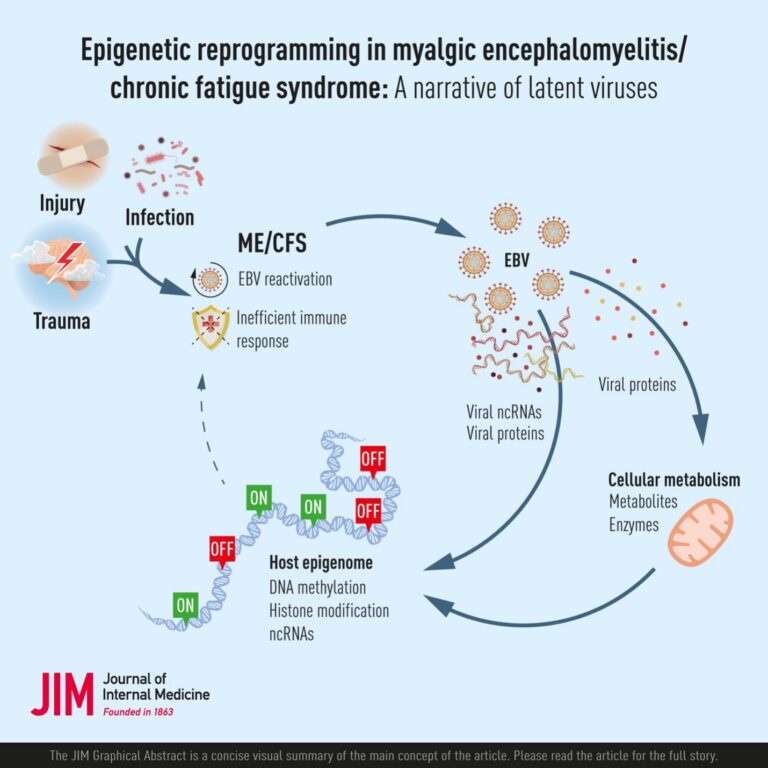Welcome to the 108th edition of Emerge Australia’s Research Digest, where we explore the latest research and media releases that are shaping our understanding of ME/CFS and long COVID. In this edition, we feature a study evaluating the application of an objective marker of ME/CFS to those with post-COVID syndrome. We also highlight recent reviews that delve into how infectious agents may contribute to pathological changes explaining ME/CFS symptoms, and how epigenetic studies may shed light on the onset, relapse, remission, and chronicity of ME/CFS. This month’s edition also emphasizes Professor Crabb’s message about the importance of preventing COVID-19 infection to reduce the impact of long COVID.
Contributing Digesters: Sarah, Solène, Shan and Simone.
You can also join our community and choose to have the Digest delivered straight to your inbox at the end of every month, by signing up to our mailing list here. We appreciate the support of everyone who reads the Digest – we encourage regular subscribers to support us with a monthly suggested donation of $2.
Impaired hand grip strength correlates with greater disability and symptom severity in post-COVID myalgic encephalomyelitis/chronic fatigue syndrome
Authors: Paffrath A, Kim L, Kedor C, Stein E, Rust R, Freitag H, … Sotzny F (Charité—Universitätsmedizin Berlin, Germany).
Publication: Journal of Clinical Medicine
Link: https://www.ncbi.nlm.nih.gov/pmc/articles/PMC11012649/
Post-COVID syndrome (PCS) can include a wide array of symptoms that last for at least two months and can impact everyday functioning. A subset of these patients fulfil the diagnostic criteria for ME/CFS. This study sought to gain a more detailed understanding of the symptoms present in ME/CFS and PCS and to establish whether hand grip strength (HGS) could be used as an objective measure of muscle fatigue, symptom severity, and physical impairment.
144 female participants diagnosed with PCS were included in this study. Participants had persistent symptoms for at least six months following COVID-19 infection. 78 of these participants also met the Canadian Consensus Criteria for ME/CFS. Hand grip strength (of the dominant hand) was assessed objectively. Self-reported measures of symptoms and disability were also assessed via questionnaires.
The authors found that PCS participants with ME/CFS showed greater overall symptom severity and degree of disability, lower physical function, and more severe fatigue compared to PCS without ME/CFS patients. HGS was impaired in both groups and was correlated with physical function. In PCS participants with ME/CFS, HGS was also associated with post-exertional malaise, pain, fatigue, cognitive impairment and orthostatic intolerance.
The authors conclude that impaired HGS could be utilised as an objective marker of physical function in patients with PCS. In patients with ME/CFS, HGS could also provide a marker for symptom severity. The authors propose that this may suggest a common mechanism for muscle fatigue seen in the subgroup of PCS patients with ME/CFS.
Herpesvirus infection of endothelial cells as a systemic pathological axis in myalgic encephalomyelitis/chronic fatigue syndrome
Authors: Nunes JM, Kell DB, Pretorius E (University of Liverpool, United Kingdom)
Publication: Viruses
Link: https://doi.org/10.3390/v16040572
This review explores the potential role of herpes virus infection in the symptomatology of ME/CFS. ME/CFS is characterised by vascular dysfunction along with platelet abnormalities that may result, at least in part, from endothelial dysfunction caused by herpes virus infection. Although very few studies investigated the impact of herpes virus infection on the endothelium in ME/CFS, Epstein Barr Virus (EBV) and human herpesvirus 6 (HHV-6) are significantly reported in ME/CFS patients.
Herpes viruses establish lifelong infection with virus latency in the nucleus of infected cells. While EBV latency in endothelial cells (ECs) is suspected, several studies have demonstrated that HHV-6 can establish latency in these cells. Herpes virus infection followed by ECs latency may explain the persistent nature of ME/CFS symptoms. Indeed, virus latency can induce endothelial dysfunction for the lifespan of EC’s, considering that both EBV and HHV-6 inhibit apoptosis of host cells. Consequently, complications may persist for months to years in accordance with the chronicity of symptoms in ME/CFS.
Latent proteins of herpesviruses, such as Epstein–Barr Nuclear Antigen-1 (EBNA-1), are sufficient to induce endothelial and vascular dysfunction. For instance, EBNA-1 increases reactive oxygen species production, enhances cell survival, and promotes DNA damage while inhibiting its repair. In the ECs, EBNA-1 increases interleukin-6 production triggering immune activation, vascular dysregulation, and increased clotting tendency. EBNA-1 also promotes the production of autoantibodies along with up-regulation of interleukin-8, hypoxia-inducible factor-1 alpha, and vascular endothelial growth factor. The latter two promote angiogenesis and influence vascular integrity and dynamics. EBV’s LMP-1, LMP-2A, as well as its RNA, are linked to cellular dysfunction and proinflammatory processes. In the case of HHV-6 latency proteins, U84 can reduce cell migration and angiogenic potential leading to prolonged wound healing.
ME/CFS is also characterised by reduced cerebral blood flow in patients. Viral infection of ECs, smooth muscle cells, and neurons might contribute to the blood flow abnormalities observed in ME/CFS. Several studies demonstrated that EBV and HHV-6 were able to reduce cerebral blood flow and perfusion of specific brain regions.
Regarding coagulation abnormalities, the EBV can disrupt platelet function by modulating their mRNA and non-coding RNA profiles. EBV infection of ECs increases von-Willebrand factor and platelet endothelial cell adhesion molecule-1 levels contributing to pro-coagulant processes. On the other hand, HHV-6 active infection triggers a prothrombotic state. Thus, herpesvirus-infected ECs and their pro-coagulant effects may cause the clotting and platelet abnormalities observed in ME/CFS.
Further research is needed to confirm whether ECs from ME/CFS patients are indeed infected with herpesviruses, which could explain the systemic and chronic nature of the disease. Other pathogens and cell types, certainly play significant roles in this pathology as well.

Figure: Overview of the paper, showing the authors’ theoretical approach, explaining the relationship between endothelial dysfunction and the role of human herpesviruses in ME/CFS
Epigenetic reprograming in myalgic encephalomyelitis
Authors: Apostolou E, Rosén A (Linköping University, Sweden)
Publication: Journal of Internal Medicine
Link: https://onlinelibrary.wiley.com/doi/10.1111/joim.13792

Figure: Graphical abstract illustrating the relationship between Epstein-Barr virus (EBV) infection, cellular metabolism and epigenetic changes in ME/CFS
In 70% of ME/CFS cases, a major stress event preceding disease onset reactivates a dormant viral infection, most predominantly from herpesviruses such as herpes simplex virus-1 and -2 (HSV-1 and HSV-2) and Epstein-Barr virus (EBV). These highly infectious agents are commonly found in the general population and are particularly skilled at evading the immune system to establish life-long latency. Approximately 95% of all adults have been infected by EBV at some point in their lifetime.
This article connects the findings of multiple epigenetic studies to explain the onset, relapse and remission, and chronicity of ME/CFS, and how a combination of epigenetic changes to both virus and host genomes potentially creates myriad downstream effects that allow symptoms to exist in perpetuity.
Epigenetic reprogramming is suggested in ME/CFS and long COVID because symptoms persevere long after the initial cause of illness, indicating the continuation of effector mechanisms, including DNA methylation, chromatin acetylation, histone modification, and alterations to microRNA (miRNA) and long non-coding RNA (lncRNA).
DNA methylation changes in ME/CFS were specific to the distinct physiological functions of different cell types. Studies have demonstrated a dysfunctional hypothalamic-pituitary-adrenal axis, indicating altered stress response. Patterns in DNA methylation tied to immune responses appear to correlate with symptom severity and fluctuate with relapse/recovery cycles, particularly in association with post-exertional malaise (PEM).
Studies of miRNAs in immune pathways could discriminate between ME/CFS and fibromyalgia patients and were indicative of metabolic state. Induction of a group of miRNAs that regulate endothelial function was independent of disease severity, whilst those related to neurotrophic receptor tyrosine kinase signalling correlated with cognitive dysfunction and sensory sensitivities.
Herpesviruses have a latent-lytic lifecycle, in which the virus hijacks the host’s cellular machinery, hiding in an inactive state within the nucleus until epigenetic factors signal reactivation. This latency-lytic cycle is hypothesised to link with recovery-relapse cycles of ME/CFS and long COVID, and could be the long-term driving force of epigenetic reprogramming, leading to cell exhaustion which increases host vulnerability to further infections. Whilst EBV is ‘epigenetically naïve’, infection causes epigenetic changes to both virus and host. For some ME/CFS patients, EBV is a key feature of their illness. The mechanisms that EBV uses to evade the immune system closely resemble the immune dysregulation described in ME/CFS. Epigenetic reprogramming causing incompetent immunosurveillance could result in increased proliferation of EBV-latent cells. Rather than initial EBV infection, or another stress event, it could be the reactivation of EBV that triggers ME/CFS. EBV may also reactivate human endogenous retroviruses (HERVs) in ME/CFS and long COVID.
The authors conclude that, like many chronic illnesses, ME/CFS likely stems from a combination of genetic predisposition and environmental factors. They hypothesise that the prolonged nature of epigenetic changes could explain the complex, systemic nature of ME/CFS and provide new targets for treatments.

Figure: Epigenetic studies in ME/CFS highlight alterations or abnormalities in four categories: immune system, cell metabolism, cardiovascular endothelial function, central autonomic nervous system.
Brendan Crabb from Burnet Institute on growing long COVID case numbers
Authors: Dyett G
Publication: SBS News
Link: https://www.sbs.com.au/news/podcast-episode/interview-brendan-crabb-from-burnet-institute-on-growing-long-covid-case-numbers/0u0rhu1t4
Burnet Institute CEO, Professor Brendan Crabb, was interviewed on SBS News’ podcast about the growing number of long COVID cases in Australia. Professor Crabb noted that there is an estimated 200-300 million people worldwide living with long COVID, and that these numbers are increasing due to the high prevalence of acute COVID infection in the community.
Professor Crabb said that research suggests that long COVID may actually be long infection, with the persistence of the SARS-CoV-2 virus in body tissue. He noted that long COVID shared many symptoms with ME/CFS and that, while there is no cure, there are things doctors can do to help alleviate symptoms. Unfortunately, many patients feel gaslit because doctors don’t understand the condition.
Professor Crabb said that because we can’t predict who will develop long COVID, the only way to avoid developing it is to avoid COVID-19 infection. He said COVID-19 messaging has become almost taboo. Despite being a serious infection, COVID-19 is being minimised. To combat long COVID, our messaging needs to be clearer about the risk of COVID infection. We need to emphasise important actions that people can take to prevent infection, like vaccination and clean air strategies.
The interview runs for 18 minutes.







